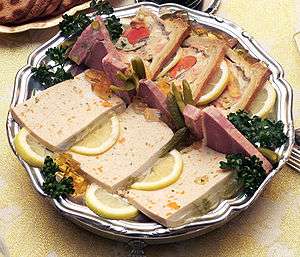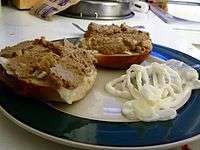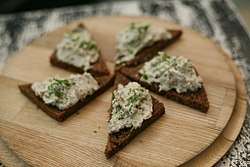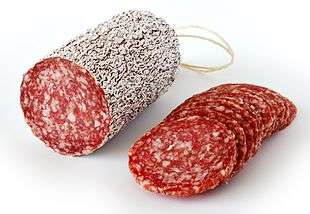Pâté
Pâté (UK: /ˈpæteɪ/ PAT-ay, US: /pɑːˈteɪ, pæˈ-/ pa(h)-TAY, French: [pɑte] (![]()
 Various pâtés | |
| Type | Spread |
|---|---|
| Place of origin | France |
| Main ingredients | Liver |
Variations
In French or Belgian cuisine, pâté may be baked in a crust as pie or loaf, in which case it is called pâté en croûte, or baked in a terrine (or other mold), in which case it is known as pâté en terrine. Traditionally, a forcemeat mixture cooked and served in a terrine is also called a terrine. The most famous pâté is probably pâté de foie gras, made from the livers of fattened geese.[1] Pâté en croûte is baked with the insertion of "chimneys" on top: small tubes or funnels that allow steam to escape, thus keeping the pastry crust from turning damp or soggy. Baked pâté en croûte usually develops an air bubble under the crust top as the meat mixture shrinks during baking; this is traditionally dealt with by infusing semi-liquid aspic in the hollow space before chilling.
In the Netherlands, Finland, Germany, Romania, Hungary, Sweden, Denmark and Austria, some liver pâtés are shaped as a soft, often spreadable sausage, called leverworst (Dutch), pate or lebăr (Romanian), májpástétom/májkrém (Hungarian), or Leberwurst (German). In the United States these are sometimes called "liverwurst" (mixing English and German), or braunschweiger. Some liverwursts can be sliced. In the US, sliced liverwurst is used as a sandwich filler. Others are spreadable as are most French or Belgian pâté; these types are more popular in the United Kingdom. In Scandinavia, leverpostej (in the Netherlands: leverpastei) is a popular baked pâté similar to the French pâté en terrine, usually made of lard and pork liver.
In Poland, pasztet is made from poultry, fish, venison, ham, or pork with eggs, flour, bread crumbs, and a varied range of additions, such as pepper, tomato sauce, mushrooms, spices, vegetables, ginger, nutmeg, cheese, or sugar.
In Russia and Ukraine, the dish is mostly prepared with beef, goose or chicken liver[2] and thus is commonly known as pechyonochniy pashtet (Russian: печёночный паштет, "liver pâté"), however other meats also can be used. Unlike the Western European method the liver is first cooked (boiled or fried) and mixed with butter or fat and seasoning such as fresh or fried onion, carrots, spices and herbs. It can be further cooked (usually baked), but most often is used without any other preparation. In Russia, the pâté is served on a plate or in a bowl, and is often molded into the shapes of animals, such as hedgehogs.[3] A similar recipe is known as chopped liver in Ashkenazi Jewish cuisine, where schmaltz is used instead of butter and hard-boiled eggs are usually added. Another common type of pâté in Jewish cuisine, also popular in Russia and Ukraine, is vorschmack or gehakte herring (chopped herring).[4][5]
In the former Yugoslavia, pašteta or паштета (a thinly pureed pâté) is a very popular bread spread usually made from chicken, beef, turkey or less commonly tuna or salmon.
In Vietnamese cuisine, pâté is commonly used on bánh mì baguette type sandwiches.[6] Pâté of this type is more commonly made from liver.
- Wild boar terrine
 Chopped liver
Chopped liver Vorschmack (chopped herring)
Vorschmack (chopped herring)
See also
References
- Julia Child (1964). Mastering the Art of French Cooking. New York, New York (USA): Alfred A. Knopf. pp. 564–576. ISBN 9785879620764. Retrieved 12 October 2017.
- enjoyyourcooking.com
- Darra Goldstein (1999). A Taste of Russia: A Cookbook of Russian Hospitality. Russian Information Service. p. 33. ISBN 9781880100424. Retrieved 12 October 2017.
- В. В. Похлебкин. Национальные кухни наших народов. Москва, изд. Пищевая пром-сть, 1980. Еврейская кухня. (William Pokhlyobkin. The Ethnic Cuisines of our Peoples. Moscow, Food Industry publishing house, 1980; Russian)
- Елена Молоховец (1861). Подарок молодым хозяйкам (in Russian). Санкт-Петербург. A Gift to Young Housewives, English translation: Joyce Stetson Toomre (1998). Classic Russian Cooking: Elena Molokhovets' a Gift to Young Housewives. Indiana University Press. ISBN 978-0-253-21210-8.
- Pork and Pâté Vietnamese Sandwich (Banh Mi)
External links

